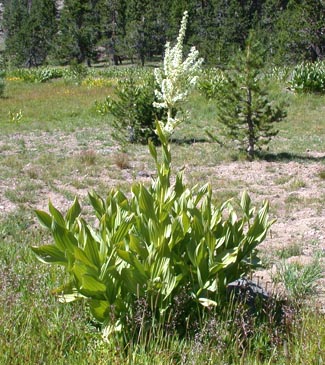False Hellebore

Common Name(s):
False Hellebore
Western False Hellebore
Skunk Cabbage
California False Hellebore
Corn Lily
Scientific Name:
Veratrum californicum Dur.
Scientific Name Synonyms:
None Known
Symbol:
VECA2
Description:
Life Span: Perennial
Origin: Native
Growth Characteristics: A native, perennial herb, 1-8 feet tall. Before the end of its growth, it will turn sunny brown and yellows.
Flowers: Flowers are in a large, terminal panicle. Petals are marked at the base with a green V-shape. Flowers are typically white in color. Three sepals and three petals are alike. The flowers are often raggedy in appearance due to the overlapping of flowers in various stages of bloom and wither. Flowers are ½ inch in size.
Fruits/Seeds: a three-chambered capsule that contains numerous brown, winged, flat seeds.
Leaves: Robust, broad, large, alternate, and three-ranked, growing up to 12 inches long, and between 3 and 6 inches wide. The leaves sheath the stem, somewhat folded, strongly parallel veined. Hairless. The leaves give the plant a corn-like appearance.
Stems: Erect, stout, unbranched, very leafy stems.
Roots: Thick and fibrous. Black rhizomes.
Ecological Adaptions:
Often grows in dense colonies in mountainous areas where moist conditions exist.
Soils: Prefers moist soils.
Associated Species: Kentucky bluegrass, Orchardgrass
Uses and Management:
The whole plant is poisonous, containing highly toxic alkaloids that affect the heart and nervous system.
Sheep which eat false hellebore while during the first trimester of pregnancy have lambs with severe abnormalities of the brain and face (known as Cyclopia).

